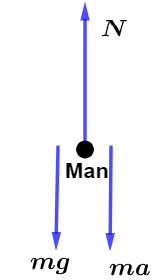
A person standing on a spring balance inside a stationary lift measures $60Kg$ The weight of that person if the lift descends with uniform downward acceleration of $1.8m{s^{ - 2}}$ will be ___ $N$. $[g = 10m{s^{ - 2}}]$
Answer
219k+ views
Hint: In order to solve this question, we will first draw the free diagram of all the forces acting on the man when the lift descends downward and then will calculate the net acceleration acting on the man which will produce the net weight effect on the spring balance.
Complete step by step solution:
Let us draw the free diagram of man as

Image: Free body diagram of a man standing in a lift.
From the drawn free diagram of man, we can see that the normal reaction $N$ of the man which will be the reading of spring balance is in the upward direction, the original weight $mg$ is in the downward direction and man is also accelerating in the downward direction with an acceleration of $a = 1.8m{s^{ - 2}}$ which will produce a force in the downward direction with magnitude $ma$.
Now, mass of the man is given as $m = 60Kg$, $g = 10m{s^{ - 2}}$ and by balancing all the three forces we can write the equation as
$mg - N = ma$
On putting the values and solving for N we get,
$N = mg - ma$
$\Rightarrow N = m(g - a)$
$\Rightarrow N = 60(10 - 1.8)$
$\therefore N = 492\,N $
Hence, the reading of the spring balance will be $492\,N$.
Note: It should be remembered that mass and weight are two different things and here we were given the mass of the man as units of mass is Kg while weight is the downward force due to gravity and its unit is Newton. Always draw the free diagram of problems where forces and their directions are necessary to solve the problems.
Complete step by step solution:
Let us draw the free diagram of man as

Image: Free body diagram of a man standing in a lift.
From the drawn free diagram of man, we can see that the normal reaction $N$ of the man which will be the reading of spring balance is in the upward direction, the original weight $mg$ is in the downward direction and man is also accelerating in the downward direction with an acceleration of $a = 1.8m{s^{ - 2}}$ which will produce a force in the downward direction with magnitude $ma$.
Now, mass of the man is given as $m = 60Kg$, $g = 10m{s^{ - 2}}$ and by balancing all the three forces we can write the equation as
$mg - N = ma$
On putting the values and solving for N we get,
$N = mg - ma$
$\Rightarrow N = m(g - a)$
$\Rightarrow N = 60(10 - 1.8)$
$\therefore N = 492\,N $
Hence, the reading of the spring balance will be $492\,N$.
Note: It should be remembered that mass and weight are two different things and here we were given the mass of the man as units of mass is Kg while weight is the downward force due to gravity and its unit is Newton. Always draw the free diagram of problems where forces and their directions are necessary to solve the problems.
Recently Updated Pages
Two discs which are rotating about their respective class 11 physics JEE_Main

A ladder rests against a frictionless vertical wall class 11 physics JEE_Main

Two simple pendulums of lengths 1 m and 16 m respectively class 11 physics JEE_Main

The slopes of isothermal and adiabatic curves are related class 11 physics JEE_Main

A trolly falling freely on an inclined plane as shown class 11 physics JEE_Main

The masses M1 and M2M2 M1 are released from rest Using class 11 physics JEE_Main

Trending doubts
JEE Main 2026: Application Form Open, Exam Dates, Syllabus, Eligibility & Question Papers

Understanding Uniform Acceleration in Physics

Derivation of Equation of Trajectory Explained for Students

Hybridisation in Chemistry – Concept, Types & Applications

Understanding the Angle of Deviation in a Prism

Understanding Collisions: Types and Examples for Students

Other Pages
JEE Advanced Marks vs Ranks 2025: Understanding Category-wise Qualifying Marks and Previous Year Cut-offs

Units And Measurements Class 11 Physics Chapter 1 CBSE Notes - 2025-26

NCERT Solutions For Class 11 Physics Chapter 8 Mechanical Properties Of Solids

Motion in a Straight Line Class 11 Physics Chapter 2 CBSE Notes - 2025-26

NCERT Solutions for Class 11 Physics Chapter 7 Gravitation 2025-26

Understanding Atomic Structure for Beginners




